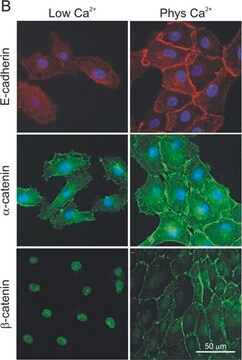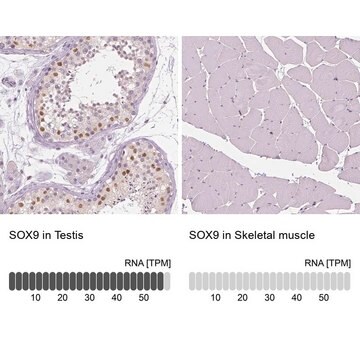MABS1327
Anti-Podocalyxin (GP135) Antibody, clone 3F2:D8
clone 3F2:D8, from mouse
Sinonimo/i:
Podocalyxin-like protein 1, GP1345, PC, PC-like protein 1, PCLP-1, cPCLP1
About This Item
Prodotti consigliati
Origine biologica
mouse
Livello qualitativo
Forma dell’anticorpo
purified immunoglobulin
Tipo di anticorpo
primary antibodies
Clone
3F2:D8, monoclonal
Reattività contro le specie
canine
Confezionamento
antibody small pack of 25 μL
tecniche
immunocytochemistry: suitable
immunofluorescence: suitable
immunoprecipitation (IP): suitable
radioimmunoassay: suitable
western blot: suitable
Isotipo
IgG1κ
N° accesso NCBI
N° accesso UniProt
Condizioni di spedizione
ambient
modifica post-traduzionali bersaglio
unmodified
Informazioni sul gene
human ... PODXL(5420)
Categorie correlate
Descrizione generale
Specificità
Immunogeno
Applicazioni
Signaling
Radioimmunoassay Analysis: A representative lot detected Podocalyxin (GP135) in Radioimmunoassay applications (Ojakian, G.K., et. al. (1988). J Cell Biol. 107(6 Pt 1):2377-87).
Immunofluorescence Analysis: A representative lot detected Podocalyxin (GP135) in Immunofluorescence applications (Ojakian, G.K., et. al. (1988). J Cell Biol. 107(6 Pt 1):2377-87; Cheng, H.Y., et. al. (2005). J Am Soc Nephrol. 16(6):1612-22).
Immunocytochemistry Analysis: A 1:100 dilution from a representative lot detected Podocalyxin (GP135) in MDCK cells (Courtesy of Dr. Tzuu-Shuh Jou, M.D., Ph.D., Graduate Institute of Clinical Medicine, College of Medicine, National Taiwan University).
Immunocytochemistry Analysis: A representative lot detected Podocalyxin (GP135) in Immunocytochemistry applications (Ojakian, G.K., et. al. (1988). J Cell Biol. 107(6 Pt 1):2377-87; Cheng, H.Y., et. al. (2005). J Am Soc Nephrol. 16(6):1612-22).
Western Blotting Analysis: A representative lot detected Podocalyxin (GP135) in Western Blotting applications (Ojakian, G.K., et. al. (1988). J Cell Biol. 107(6 Pt 1):2377-87; Cheng, H.Y., et. al. (2005). J Am Soc Nephrol. 16(6):1612-22).
Immunoprecipitation Analysis: A representative lot detected Podocalyxin (GP135) in Immunoprecipitation applications (Ojakian, G.K., et. al. (1988). J Cell Biol. 107(6 Pt 1):2377-87; Cheng, H.Y., et. al. (2005). J Am Soc Nephrol. 16(6):1612-22).
Qualità
Western Blotting Analysis: A 1:1,000 dilution of this antibody detected Podocalyxin (GP135) in MDCK cell lysate.
Descrizione del bersaglio
Stato fisico
Stoccaggio e stabilità
Altre note
Esclusione di responsabilità
Non trovi il prodotto giusto?
Prova il nostro Motore di ricerca dei prodotti.
Codice della classe di stoccaggio
12 - Non Combustible Liquids
Classe di pericolosità dell'acqua (WGK)
WGK 1
Punto d’infiammabilità (°F)
Not applicable
Punto d’infiammabilità (°C)
Not applicable
Certificati d'analisi (COA)
Cerca il Certificati d'analisi (COA) digitando il numero di lotto/batch corrispondente. I numeri di lotto o di batch sono stampati sull'etichetta dei prodotti dopo la parola ‘Lotto’ o ‘Batch’.
Possiedi già questo prodotto?
I documenti relativi ai prodotti acquistati recentemente sono disponibili nell’Archivio dei documenti.
Il team dei nostri ricercatori vanta grande esperienza in tutte le aree della ricerca quali Life Science, scienza dei materiali, sintesi chimica, cromatografia, discipline analitiche, ecc..
Contatta l'Assistenza Tecnica.








